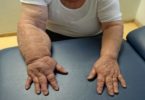What's in this article?
What is Genital Warts?
Genital warts are one of the most common types of sexually transmitted infections. Nearly all sexually active people will become infected with at least one type of human papillomavirus (HPV), the virus that causes genital warts, at some point during their lives. Women are somewhat more likely than men to develop genital warts.
As the name suggests, genital warts affect the moist tissues of the genital area. Genital warts may look like small, flesh-colored bumps or have a cauliflower-like appearance. In many cases, the warts are too small to be visible.
Like warts that appear elsewhere on your body, genital warts are caused by the human papillomavirus (HPV). Some strains of genital HPV can cause genital warts, while others can cause cancer. Vaccines can help protect against certain strains of genital HPV.
Causes of Genital Warts
There are over 100 types of human papillomaviruses (HPVs) that infect humans. Of these, more than 40 types can infect the genital tract and anus (anogenital tract) of men and women. Sometimes, they cause genital lesions known as condylomata acuminata or venereal warts. A subgroup of the HPVs that infect the anogenital tract can lead to precancerous changes in the uterine cervix and cervical cancer. HPV infection is also associated with the development of other anogenital cancers. The HPV types that cause cervical cancer have also been linked with both anal and penile cancer in men as well as a subgroup of head and neck cancers in both women and men. Genital warts and HPV infection are transmitted primarily by sexual intimacy, and the risk of infection increases as the number of sexual partner’s increases.
The most common HPV types that infect the anogenital tract are HPV types 6, 11, 16, and 18 (HPV-6, HPV-11, HPV-16, and HPV-18), although other HPV types can also cause infection. Among these, HPV-6 and HPV-11 are most commonly associated with benign lesions such as genital warts are termed “low-risk” HPV types. In contrast, HPV-16 and HPV-18 are the types found most commonly in cervical and anogenital cancers as well as severe dysplasia of the cervix. These belong to the so-called “high-risk” group of HPVs.
Other HPV types infect the skin and cause common warts elsewhere on the body. Some types of HPVs (for example, HPV 5 and 8) frequently cause skin cancers in people who have a condition known as epidermodysplasia verruciformis (EV).
Early Signs of Genital Warts
Genital warts come in various sizes and shapes. Common symptoms of genital warts include:
- Small bumps (up to 2-3cm for) that are skin-coloured and often grow in clusters forming a sort of cauliflower shape
- Some people only have one or two warts. When these growths are located directly in the genital area, they are usually soft-to-the-touch and can be either raised or flat.
- Most of the time, genital warts appear in moist areas (e.g. in or around the vagina, anus or groin) and do not cause discomfort or pain. In rare cases, they can be itchy, hurt a bit or bleed – especially if you scratch them.
Risk factors for Genital Warts
Any sexually active person is at risk for HPV. According to the American Academy of Dermatology (AAD), nearly half of people who have sex have had some type of HPV infection. However, genital warts are common for people who meet the following criteria:
- are under the age of 30
- smoke
- have immune system weaknesses
- have a history of child abuse
- if their mother had the virus during childbirth
Treatment for Genital Warts
Very often our bodies fight off the virus. If so, the warts go away with no treatment. That’s why a lot of people choose to just wait for the warts to go away on their own. But you may choose to get genital warts treatments if the warts are uncomfortable, get in the way of sex play, or you don’t like the way they look.
Warts can be removed with various genital warts treatments. Talk with your health care provider to decide which treatment might be best for you.
There are several medicines that can be applied directly to genital warts, depending on where they are located. Some prescription genital warts treatments can be used at home. Other treatments must be applied by your health care provider. Some genital warts treatments can cause discomfort. And some cannot be used during pregnancy.
Genital warts also may be removed by freezing them. This is called cryotherapy. They may be burned off. This is called electrocauterization. Or they may be removed with surgery or with lasers. In some cases, they are treated with injections of interferon, another type of medication.
Like all medications, genital warts treatments have risks and side effects. Your health care provider can explain them to you and help you deal with the side effects of your treatment.
After having genital warts treatment
- Keep the area clean.
- Don’t scratch the treated area.
- Wash your hands after touching the warts.
- Avoid sexual contact if it is uncomfortable.
- Apply cold compresses to relieve discomfort, or you may take acetaminophen (Tylenol) or ibuprofen (Advil or Motrin).
For most people, the first series of genital warts treatment is successful in removing the warts. But even though the warts go away with treatment, they may return. This is because the treatments can remove the warts, but they don’t cure the virus that causes warts.
For some people, the warts may come back several months after treatment especially if they smoke cigarettes. And for some people, the warts continue to return, even after long periods of time.






Leave a Comment